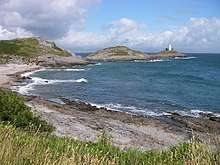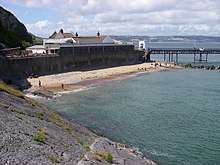Hunts Bay Oolite
Hunts Bay Oolite is an oolitic carboniferous limestone geological formation found in the south Wales region. It is named after Hunts Bay on the Gower peninsula, south-south west of Bishopston, where a significant amount of the limestone forms the cliffs there.


| Hunts Bay Oolite Stratigraphic range: Holkerian | |
|---|---|
| Type | Formation |
| Unit of | Carboniferous Limestone Supergroup |
| Sub-units | Pembroke Limestone Group |
| Underlies | Oxwich Head Limestone Formation |
| Overlies | High Tor Limestone Formation |
| Lithology | |
| Primary | Carbonate rock |
| Other | Oolite |
| Location | |
| Region | Wales |
| Country | United Kingdom |
| Type section | |
| Named for | Hunts Bay, Gower Peninsula |
Hunts Bay Oolite is a sub-group of the Pembroke Limestone Group which itself is part of the Carboniferous Limestone Supergroup.[1][2][3]
Oolite means 'egg stone': very small grains (up to 2mm) form by accumulating precipitated minerals, usually calcium carbonate. These ooids, created in a warm, tropical environment, are the precursors to the limestone.[4][5]
The Hunts Bay Oolite extends from Pembroke in the West to Monmouth and Chepstow in the East and northwards into the Dowlais formation around Merthyr Tydfil. Fossils, such as brachiopods and crinoids associated with a shallow sea environment, can be found in the rock. East of the south Wales coalfield and in the south east the rock is increasingly dolomitised (where some calcium is replaced by magnesium).[1]
This subgroup lies in time largely in the (British geological) Holkerian substage of the Viséan stage of the stratigraphic column, from 337 to 333.5 million years ago. At the time, the rocks of Europe were much closer to the equator.[6][7]
References
- British Geological Survey. "Hunts Bay Oolite Subgroup". www.bgs.ac.uk. Retrieved 21 October 2017.
- British Geological Survey. "Pembroke Limestone Group". www.bgs.ac.uk. Retrieved 21 October 2017.
- British Geological Survey. "Carboniferous Limestone Supergroup". www.bgs.ac.uk. Retrieved 18 October 2017.
- Online Research @ Cardiff. "Sedimentology, sea-level history and porosity evolution of the Holkerian (Lower Carboniferous) of Gower". orca.cf.ac.uk. Retrieved 21 October 2017.
- Waters (Ed.), Colin (2011). "A revised correlation of Carboniferous rocks in the British Isles: South Wales" (PDF). Geological Society of London: 29–36. Archived from the original on 4 July 2012. Retrieved 21 October 2017.CS1 maint: extra text: authors list (link)
- Visean, Dinantian, Carboniferous, Wales. "Visean, Dinantian, Carboniferous, Wales". earthwise.bgs.ac.uk. Retrieved 21 October 2017.CS1 maint: multiple names: authors list (link)
- BGS Geological timechart. "BGS Geological timechart". www.bgs.ac.uk. Retrieved 21 October 2017.
- Various Contributors to the Paleobiology Database. "Fossilworks: Gateway to the Paleobiology Database". Archived from the original on 31 July 2014. Retrieved 8 July 2014.